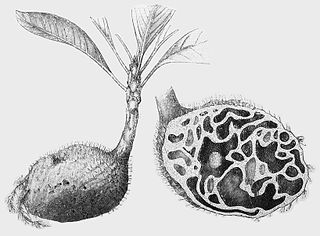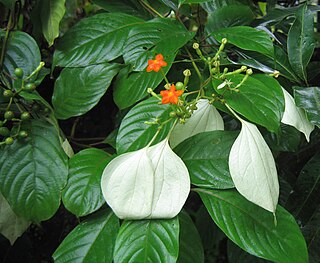
Nauclea is a genus of flowering plants in the family Rubiaceae. The species are evergreen trees or shrubs that are native to the paleotropics. The terminal vegetative buds are usually strongly flattened. The generic name is derived from the Ancient Greek words naus, meaning "ship" and kleio, meaning "to close". It refers to the resemblance of the cells of the capsule to a ship's hull.

Antirhea is a genus of flowering plants in the family Rubiaceae.

Canthium is a genus of flowering plants in the family Rubiaceae. They are shrubs and small trees. The leaves are deciduous and the stems are usually thorny.

Saurauia is a genus of plants in the family Actinidiaceae. It comprises about over 300 species distributed in the tropics and subtropics of Asia and South and Central America. Genetic evidence and the cell biology of the group support monophyly of the genus. Monophyly of the genus is also supported by micromorphological characters and by phylogenetic analysis, although the exact evolutionary relationships of Saurauia with the other two genera of the Actinidiaceae, Actinidia and Clematoclethra, are not well understood. It is also the only extant genus within its family whose natural distribution includes areas outside of Asia.

Argostemma is a genus of flowering plants in the family Rubiaceae. It can be found in (sub)tropical Asia and western and west-central tropical Africa.

Hydnophytum is a genus of epiphytic myrmecophytes native to Southeast Asia, the Pacific region and also extending into Queensland in northern Australia. The name is derived from the Ancient Greek hydnon "tuber", and phyton "plant", after their appearance with their swollen succulent stems. The species grow in tree branches and on trunks. Like the related genus Myrmecodia, they are known as antplants or ant-house plants. The type species is Hydnophytum formicarum from the Philippines. The genus contains 55 species, of which 44 are found in and around the island of New Guinea. Many are poorly known, with 11 known only from the holotype.

Neonauclea is a genus of flowering plants in the family Rubiaceae. It comprises about 71 species. Neonauclea is a genus of shrubs and trees They are indigenous to China, India, Southeast Asia, Wallacea, New Guinea and Australia.
Acranthera is a genus of flowering plants in the family Rubiaceae. It is found from India to South Central China south to Borneo and the Philippines.
Amaracarpus is a genus of shrubs, treelets or trees in the family Rubiaceae. It was described by Carl Ludwig Blume in 1826. Most of the species are endemic to New Guinea but a few have wider ranges in Southeast Asia from Myanmar (Burma) and the Andaman Islands across Thailand, Malaysia, Indonesia, the Philippines, Melanesia, Christmas Island, Queensland and Vanuatu. One species also occurs in the Seychelles. Several species were published years ago but are today not represented by any type specimens or other known existing material.
Antherostele is a genus of flowering plants in the family Rubiaceae. It is endemic to the Philippines.

Mussaenda is a genus of flowering plants in the family Rubiaceae. They are native to the African and Asian tropics and subtropics. Several species are cultivated as ornamental plants.
Villaria is a genus of plants in the family Rubiaceae. It contains 5 accepted species, all endemic to the Philippines.
Kajewskiella is a genus of plants in the family Rubiaceae.
Coptosapelta is a genus of flowering plants in the family Rubiaceae. It is found in tropical and subtropical Asia. The genus has not been placed within a subfamily and is sister to the rest of Rubiaceae.
Diplospora is a genus of flowering plants in the family Rubiaceae. The genus is found in tropical and subtropical Asia.
Dolianthus is a genus of flowering plants in the family Rubiaceae. The genus is endemic to New Guinea.
Aleisanthieae is a tribe of flowering plants in the family Rubiaceae and contains 10 species in 3 genera. Its representatives are found in Borneo, Malaysia, and the Philippines.

Gynochthodes is a genus of flowering plants in the family Rubiaceae. The genus is found from Madagascar to tropical and subtropical Asia and the Pacific region.
Ridsdalea is an Asian genus of plants in the family Rubiaceae; it was named after Dr. Colin Ridsdale. The type species is Ridsdalea grandis(Korth.) J.T.Pereira, which was re-named from the basionym Gardenia grandis. Several other species have been re-assigned from other genera: notably Rothmannia, which is now reserved for African species. Its native range is southern China, Indo-China, Malesia and New Guinea.
Uncaria perrottetii, known locally in the Philippines as “sungay kalabaw”, is a species of liana in the family Rubiaceae.








